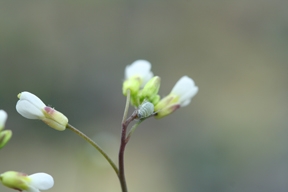
The plant-grazing bugs accomplish this by forcing the plants to create diverse natural defenses to avoid being eaten, which in turn shapes the genetic makeup of the plants in a region. The researchers discovered this by studying aphids and the broccoli-like research plant Arabidopsis thaliana. Their findings provide the first measurable evidence that this selective process is driven, in part, by the pressure that multiple natural enemies exert on plants by forcing them to create diverse natural defenses to avoid being eaten.
“Our data demonstrate that there is a link between the abundance of two types of aphids and the continental distribution of Arabidopsis plants that are genetically different in terms of the biochemicals they produce to defend against insect feeding,” said UC Davis plant scientist Dan Kliebenstein.
His laboratory is examining the naturally occurring chemicals involved with plant defenses to better to understand their role in the environment and to explore their potential for improving human nutrition and fighting cancer.
Ecologists have theorized for decades that genetic change and variation within a plant or animal species is critical to enabling the species to survive changing environmental conditions like the appearance of a new disease or pest.
They have documented that nonbiological changes, such as variations in climate and soil, can exert pressures that cause genetic variation within plant species. However there has been little evidence that biological forces, including insects feeding on plants or competition between plant species, can lead to genetic variation within a plant species across a large geographic area.
In the new study, the researchers first mapped the distribution of six different chemical profiles within Arabidopsis thaliana plants across Europe, each chemical profile controlled by the variation in three genes.
The mapping revealed a change in the function of one of these key genes across geographic areas; the gene changed from southwest to the northeast.
The researchers suspected that two aphid species — Brevicoryne brassicae and Lipaphis erysimi — were the likely causes of the geographic variation. Both are abundant in the regions and feed heavily on Arabidopsis and related plants.
The scientists then tapped data collected by British researchers for nearly 50 years on fluctuations in aphid populations in Europe. They found that distribution of the two aphids species of interest closely mirrored the geographic distribution of the different chemical types of Arabidopsis plants. Like picky restaurant goers, one aphid preferred the southwestern chemical type while the other aphid preferred the northeastern chemical type.
The next step was to determine whether the similarity between the distribution patterns of the plants and the two aphid species was more than coincidental. To do this, the researchers observed what happened when the different aphids fed on five generations of experimentally raised Arabidopsis thaliana plants.
They confirmed that the plants were genetically adapting to the aphids, with each successive plant generation showing less damage from the feeding insects. A change in the genetic makeup of the plant populations specific to each aphid accompanied this trend — and the laboratory plants evolved in a way that tracked the geographic distribution of the two aphids and the plant chemical types.
The researchers also found that when faced with feeding by aphids, the faster-growing Arabidopsis plant types fared better in the laboratory, while the slowest-growing plant types actually went experimentally extinct.
“These data make it clear that even functionally similar plant-eating pests can affect the biochemical and genetic makeup of plant populations, playing a major role in shaping and refining the plant defenses in a natural community,” Kliebenstein said.
You’ll be able to read the complete report on this study, conducted with researchers in Switzerland, Denmark, England and the United States, will appear in the Oct. 5 issue of the journal Science.